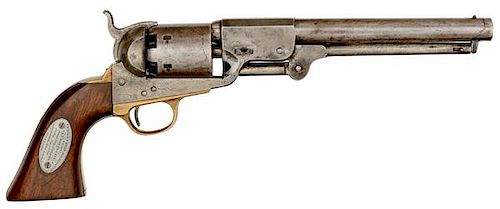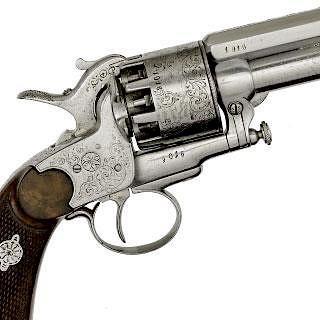Leech & Rigdon Percussion Revolver Captured from the C.S.S. Tennessee at Mobile Bay
About Seller
6270 Este Ave.
Cincinnati , OH 45232
United States
With offices in Cincinnati, Cleveland and Denver, Cowan’s holds over 40 auctions each year, with annual sales exceeding $16M. We reach buyers around the globe, and take pride in our reputation for integrity, customer service and great results. A full-service house, Cowan’s Auctions specializes in Am...Read more
Two ways to bid:
- Leave a max absentee bid and the platform will bid on your behalf up to your maximum bid during the live auction.
- Bid live during the auction and your bids will be submitted real-time to the auctioneer.
Bid Increments
| Price | Bid Increment |
|---|---|
| $0 | $25 |
| $500 | $50 |
| $1,000 | $100 |
| $2,000 | $250 |
| $5,000 | $500 |
| $10,000 | $1,000 |
| $20,000 | $2,500 |
| $50,000 | $5,000 |
| $100,000 | $10,000 |
About Auction
Apr 26, 2016 - Apr 28, 2016
Cowan's Auctions dawnie@cowans.com
- Lot Description
.36 caliber, 7.5" part octagonal-to-round barrel, S/N 605. Cryptic four dots under the serial number on the trigger guard. Marked on top of barrel flat Leech & Rigdon CSA. Blued finish with brass backstrap and trigger guard. One piece walnut grips with silver oval plaque inlaid in the right grip, and engraved in block letters and flowing script: Ensign P. Fred Harrington U.S. Navy, USS Monongahela, Mobile Bay Alabama Friday, Aug 5th 1864 Captured with the Rebel Ironclad Tennessee.
A recent in-depth study on the Leech & Rigdon and Rigdon-Ansley Confederate revolvers sheds light on the approximate date of manufacture of this revolver. Leech & Rigdon moved their base of operations to Greensboro, Georgia in late 1862. At that point, the serial number range approached as high as 400 revolvers. Therefore, it can be surmised that this revolver (S/N 605) was manufactured during the early months of 1863, and indicates that it was in Confederate service for approximately eighteen months before its capture in Mobile Bay in early August, 1864.
Ensign Purnell Frederick Harrington of Dover, Delaware was appointed midshipman at the U.S. Naval Academy in September. 1861 and ordered into active service in September, 1863. Promoted to acting Ensign on October 1, 1863, he served on the Ticonderoga, Niagara and was attached to the steam-sloop Monongahela, West Gulf Blockading Squadron, 1864-1865. Harrington was an active participant in the battle of Mobile Bay on August 5, 1864.
After Mobile Bay, Harrington continued his service in the Navy with the Monongahela, rising to the rank of Lieutenant Commander in 1868. He served continuously thereafter, retiring June 6, 1906 as a Rear Admiral and died in Yonkers, NY Oct. 20, 1937.
The Union Navy's assault on their Confederate counterparts protecting the strategically important Mobile Bay was one of the most heralded Naval actions of the Civil War. On August 5, 1864, Admiral David Farragut took his stripped-for-action squadron of 18 ships and four monitors into the bay to test the Confederate defenses. The steam sloop Monongahela was part of the assaulting fleet. Farragut was met by his Confederate counterpart, Admiral Franklin Buchannan aboard his flagship, the immense, heavy ram, Tennessee. In the ensuing battle, the Monongahela performed valiantly, bombarding several Confederate forts, and finally, at top speed, rammed the heavily armored Tennessee, actually mounting her, but sliding off her sloping sides. Damaged, the Monongahela continued to fight until the Tennessee surrendered about an hour later to the superior Union forces. According to the Official Records of the Union and Confederate Navies (Series 1, Volume 21:841), besides the ship's Captain and Admiral Buchanan, 19 prisoners were taken from the Tennessee.
In a letter to his brother Sam, written on August 18, 1864, Ensign Harrington described the battle and the role of his ship, the Monongahela. In describing the Tennessee and the damage it incurred during the fight, he noted "Immediately after the fight, I went on board the ram." While Harrington makes no mention of "capturing" Leech and Rigdon S/N 605, his letter home makes it abundantly clear he had the opportunity to collect a souvenir of war.
LITERATURE:
Duncan, Richard P.
1978 "The Storming of Mobile Bay." The Alabama Historical Quarterly, Vol. XL (1-2):6-19.
Gary, William A.
1987 Confederate Revolvers. K8 Communications, p. 21.
Hartzler, Daniel D.
1989 Confederate Presentation and Inscribed Swords and Revolvers. Olde Soldier Books, Inc. p. 324.
Pictured within a photograph of Clifford Young’s display on the "Battle of Mobile Bay," ASAC Bulletin #64, May 1991: page 59.
Pictured on page 99 within a photograph of Clifford Young’s display on the Battle of Mobile Bay, ASAC Bulletin #107, May 2013.
Wall, Kent. "Leech & Rigdon Re-Visited," ASAC Bulletin #103, April 2011: pp 41-51.
Provenance:
Herb Glass
William Florence
M. Clifford Young Collection
This revolver still retains considerable original bright blue finish. Very sharp edges and lines. Backstrap and trigger guard have a nice untouched patina. Rear part of the cylinder still retains all of the original cylinder pins. Grips still retain most of the original varnish. Superb example of a Leech & Rigdon. With this revolver comes a notebook of research.Condition
- Shipping Info
-
SHIPPING. At the request of the buyer, Cowan's will authorize the shipment of purchased items. Shipments usually occur within two weeks after payment has been received. Shipment is generally made via UPS Ground service. Unless buyer gives special instructions, the shipping method shall be at the sole discretion of Cowan's Auctions, Inc.. Cowan's is in no way responsible for the acts or omissions of independent handlers, packers or shippers of purchased items or for any loss, damage or delay from the packing or shipping of any property.
-
- Buyer's Premium



 EUR
EUR CAD
CAD AUD
AUD GBP
GBP MXN
MXN HKD
HKD CNY
CNY MYR
MYR SEK
SEK SGD
SGD CHF
CHF THB
THB















